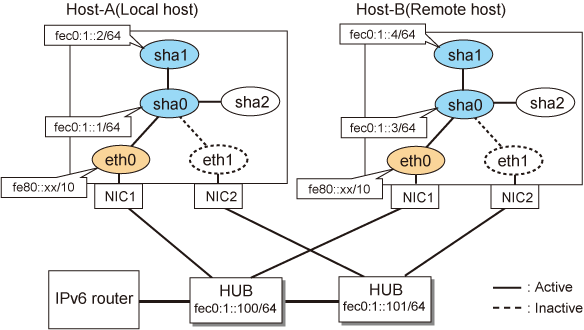This section describes an example configuration procedure of the network shown in the diagram below.
The xx in the figure below are assigned automatically by the automatic address configuration.
For the network configuration other than GLS, refer to "3.2.2 Network configuration".

[HOST-A]
1) Setting up the system
1-1) Define IP addresses and hostnames in /etc/hosts file. Note that it is not necessary to define an IPv6 address, which automatically allocates address by the Stateless Address Autoconfiguration feature.
fec0:1::1 v6hosta1 # HOST-A Virtual IP fec0:1::2 v6hosta2 # HOST-A Virtual IP fec0:1::3 v6hostb1 # HOST-B Virtual IP fec0:1::4 v6hostb2 # HOST-B Virtual IP fec0:1::100 swhub1 # Primary HUB IP fec0:1::101 swhub2 # Secondary HUB IP |
1-2) Configure /etc/sysconfig/network-scripts/ifcfg-ethX (X is 0,1) file as follows.
Note
The following setting example (/etc/sysconfig/network-scripts/ifcfg-ethX) is for RHEL5. For details, see "3.2.2 Network configuration".
Contents of /etc/sysconfig/network-scripts/ifcfg-eth0
DEVICE=eth0 BOOTPROTO=static HWADDR=XX:XX:XX:XX:XX:XX HOTPLUG=no ONBOOT=yes TYPE=Ethernet |
Contents of /etc/sysconfig/network-scripts/ifcfg-eth1
DEVICE=eth1 BOOTPROTO=static HWADDR=XX:XX:XX:XX:XX:XX HOTPLUG=no ONBOOT=yes TYPE=Ethernet |
1-3) When the system is RHEL, on /etc/sysconfig/network file, define a statement allows the system to load IPv6 module.
NETWORKING=yes NETWORKING_IPV6=yes IPV6TO4INIT=no |
2) Reboot
Run the following command and reboot the system. After rebooting the system, verify eth0 is enabled as an IPv6 interface using ifconfig command.
/sbin/shutdown -r now
3) Creating of virtual interface
/opt/FJSVhanet/usr/sbin/hanetconfig create inet6 -n sha0 -m d -i fec0:1::1/64 -t eth0,eth1 /opt/FJSVhanet/usr/sbin/hanetconfig copy inet6 -n sha0,sha1 -i fec0:1::2/64
4) Setting up the HUB monitoring function
/opt/FJSVhanet/usr/sbin/hanetpoll create -n sha0 -p fec0:1::100,fec0:1::101 -b off /opt/FJSVhanet/usr/sbin/hanetpoll copy -n sha0,sha1
5) Setting up the Standby patrol monitoring function
/opt/FJSVhanet/usr/sbin/hanetconfig create -n sha2 -m p -t sha0
6) Activating of virtual interface
/opt/FJSVhanet/usr/sbin/strhanet -n sha0 /opt/FJSVhanet/usr/sbin/strhanet -n sha1
7) Starting the HUB monitoring function
/opt/FJSVhanet/usr/sbin/hanetpoll on
[HOST-B]
1) Setting up the system
1-1) Define IP addresses and hostnames in /etc/hosts file. Defined content is same as HOST-A.
1-2) Configure /etc/sysconfig/network-scripts/ifcfg-ethX (X is 0,1) file as follows.
Note
The following setting example (/etc/sysconfig/network-scripts/ifcfg-ethX) is for RHEL5. For details, see "3.2.2 Network configuration".
Contents of /etc/sysconfig/network-scripts/ifcfg-eth0
DEVICE=eth0 BOOTPROTO=static HWADDR=XX:XX:XX:XX:XX:XX HOTPLUG=no ONBOOT=yes TYPE=Ethernet |
Contents of /etc/sysconfig/network-scripts/ifcfg-eth1
DEVICE=eth1 BOOTPROTO=static HWADDR=XX:XX:XX:XX:XX:XX HOTPLUG=no ONBOOT=yes TYPE=Ethernet |
1-3) When the system is RHEL, on /etc/sysconfig/network file, define a statement allows the system to load IPv6 module.
NETWORKING=yes NETWORKING_IPV6=yes IPV6TO4INIT=no |
2) Reboot
Run the following command and reboot the system. After rebooting the system, verify eth0 is enabled as an IPv6 interface using ifconfig command.
/sbin/shutdown -r now
3) Creating of virtual interface
/opt/FJSVhanet/usr/sbin/hanetconfig create inet6 -n sha0 -m d -i fec0:1::3/64 -t eth0,eth1 /opt/FJSVhanet/usr/sbin/hanetconfig copy inet6 -n sha0,sha1 -i fec0:1::4/64
4) Setting up the HUB monitoring function
/opt/FJSVhanet/usr/sbin/hanetpoll create -n sha0 -p fec0:1::100,fec0:1::101 -b off /opt/FJSVhanet/usr/sbin/hanetpoll copy -n sha0,sha1
5) Setting up the Standby patrol monitoring function
/opt/FJSVhanet/usr/sbin/hanetconfig create -n sha2 -m p -t sha0
6) Activating of virtual interface
/opt/FJSVhanet/usr/sbin/strhanet -n sha0 /opt/FJSVhanet/usr/sbin/strhanet -n sha1
7) Starting the HUB monitoring function
/opt/FJSVhanet/usr/sbin/hanetpoll on